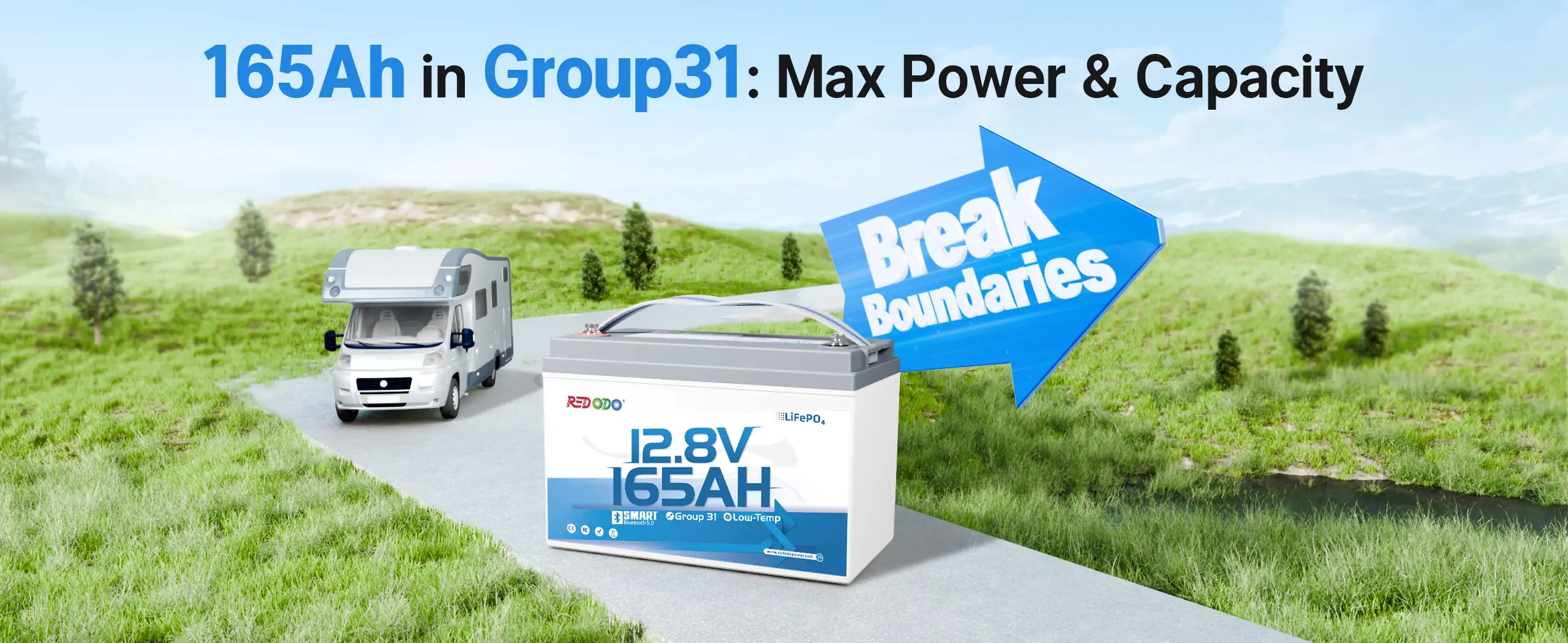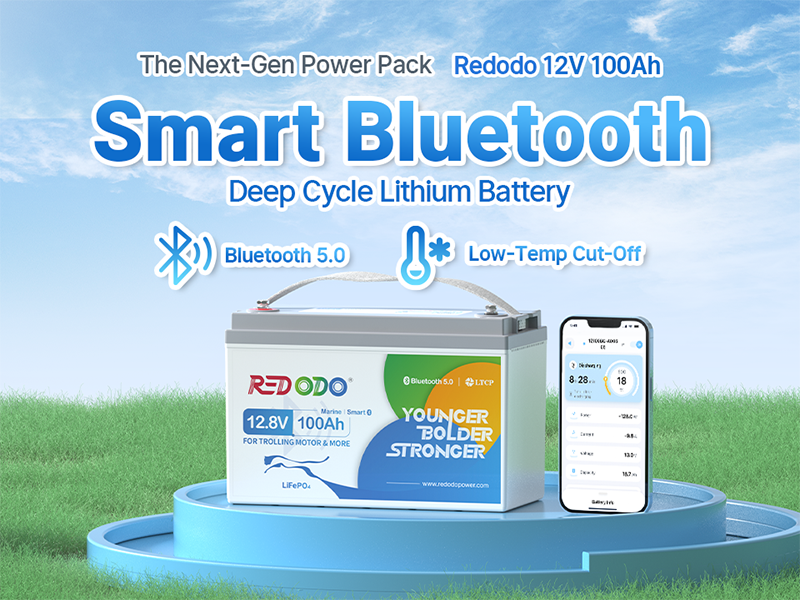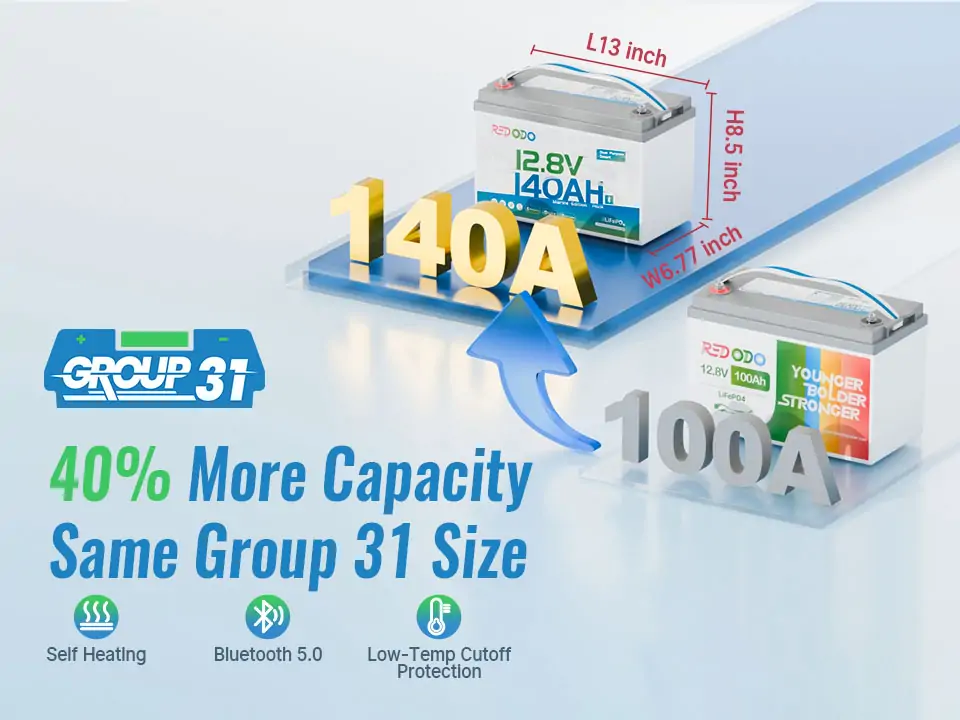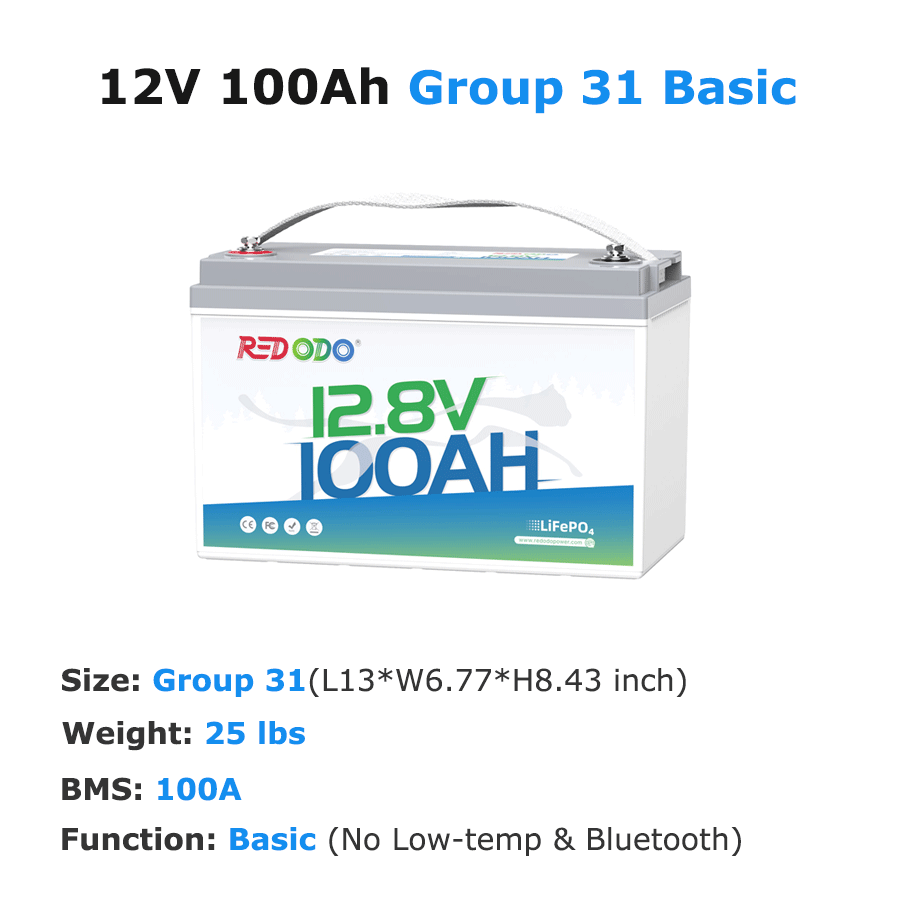Group 31 Battery Dimensions, Features & Applications
A Group 31 battery is a popular choice in RVs, boats, trucks, and off-grid systems. In this article, we’ll explore the dimension, features, advantages and disadvantages of Group 31 batteries, and give you some Group 31 battery options with good performance.
We’ll cover the following topics to help you make an informed choice:
- Examine the definitions and common dimensions of Group 31 batteries.
- Compare different types of Group 31 batteries—Lithium, AGM, Gel, and Flooded, and their different features.
- Explore the applications of group 31 batteries, including off-grid system, RVs, marine, solar, industrial, and commercial.
- List the best Group 31 batteries to help you determine which best suits your needs.
Table of Content
- What is A Group 31 Battery?
- Dimensions of Group 31 Batteries
- Types of Group 31 Batteries
- Applications of Group 31 Battery
- Best Recommended Group 31 Batteries
- FAQs about Group 31 Battery
What is A Group 31 Battery?
A Group 31 battery is a specific size category of battery, commonly used in commercial trucks, recreational vehicles (RVs), boats, and other applications that require reliable power over long periods. The term "Group 31" refers to the battery's physical dimensions and its general capacity and performance characteristics, which are standardized by the Battery Council International (BCI).
Dimensions of Group 31 Batteries
Group 31 batteries have specific dimensions measuring 13 x 6.8 x 9.44 inches (330 x 173 x 240 mm). These batteries are primarily used in semi-trucks and other deep cycle applications, such as off-the-grid systems and marine use.
With a nominal capacity of 75Ah to 125Ah, they are known for their high amp-hour (Ah) ratings, making them ideal for power-intensive tasks that require a prolonged power supply.
Below is the chart of most common battery sizes.
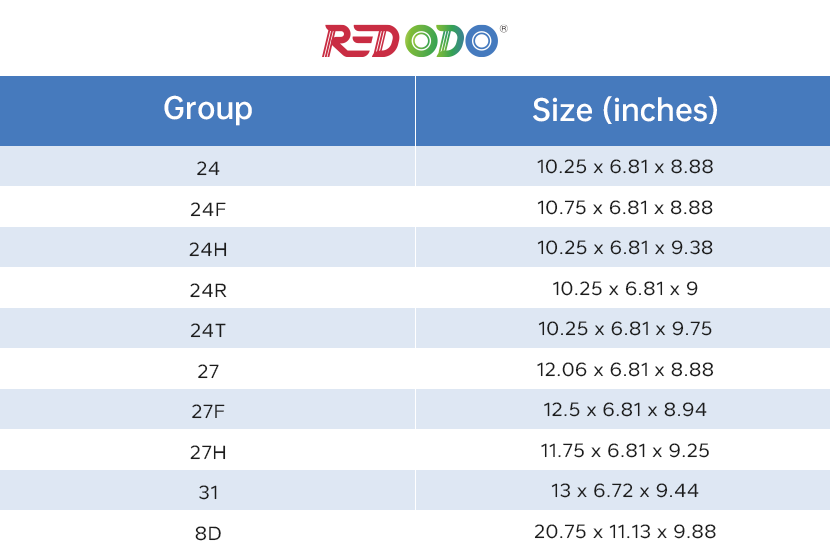
Explore Redodo's Group 31 Deep Cycle Batteries, and upgrade your Group 31 Battery System now!
Types of Group 31 Batteries
Group 31 batteries come in various types, including Flooded Lead Acid Batteries (FLA), Absorbent Glass Mat Batteries (AGM), Gel batteries, and Lithium-ion (LiFePO4) options. Each type offers distinct features that cater to the specific needs of users in different situations. In order to better understand these batteries, let's delve into each type and its own specific features and advantages:
1. Group 31 Flooded Lead Acid Batteries
Flooded lead acid batteries(FLA), a type of Group 31 battery, require regular maintenance, such as monitoring corrosion levels and replenishing electrolyte levels, to ensure optimal performance. Without proper maintenance, the already limited lifespan of these batteries will be further reduced. Additionally, they need to be consistently charged to prevent damage. While flooded lead acid batteries may offer short-term cost savings, they ultimately end up costing more in the long run, especially when compared to lithium batteries.
Pros
- Affordable compared to other types.
- Widely available.
- Can handle high current demands.
Cons
- Require regular maintenance such as topping up with distilled water.
- Prone to spills and leaks if not handled properly.
- Not completely sealed, which can lead to corrosion and electrolyte loss.
2. Group 31 AGM Batteries
Absorbent Glass Mat (AGM) batteries use a glass mat separator to hold the electrolyte, eliminating the need for maintenance and allowing them to be mounted in any position. AGM batteries are more expensive but offer higher vibration resistance and longer lifespan compared to FLA batteries. Generally, AGM batteries last up to six years.
Pros
- Maintenance-free, no need for adding water or electrolyte checks.
- Excellent deep cycle capabilities.
- Can handle high discharge rates.
- Resistant to vibration and shock.
Cons
- Generally more expensive than FLA batteries.
- Can be damaged if overcharged.
- Slightly lower energy storage capacity compared to FLA batteries.
3. Group 31 Gel Batteries
Gel batteries use silica to transform the electrolyte into a gel-like substance. They are known for their deep cycling capabilities and excellent performance in hot temperatures. Gel batteries are more expensive than AGM batteries but have a longer lifespan.
Pros:
- Excellent vibration resistance, making them suitable for off-road and marine applications.
- Good deep discharge recovery.
- Maintenance-free with no need for adding water or electrolyte checks.
Cons:
- More expensive compared to FLA and AGM batteries.
- Lower energy density compared to AGM batteries.
- Sensitive to temperature extremes.
4. Group 31 Lithium Batteries
Group 31 lithium batteries are known for their wide range of features and advantages. These batteries are lightweight, have high energy density, charge quickly, and require no maintenance. They have a long lifespan of over 3,000 cycles and can operate in various temperatures, making them environmentally friendly options. Some advanced lithium batteries, like Redodo, offer even higher charge cycles 4000-15000 and longer lifespans.
With a built-in battery management system (BMS), Group 31 lithium batteries are also safer. They have a low self-discharge rate, meaning they can hold their charge for extended periods of time. This makes them ideal for emergency backup power or for use in vehicles that may be parked for long periods without use.
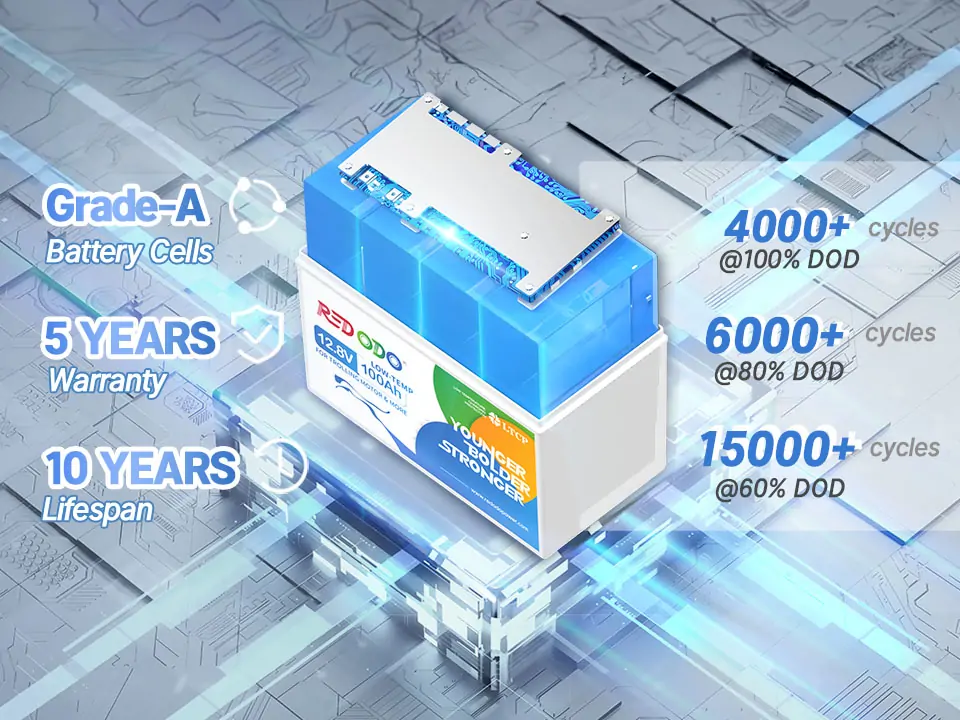
In addition, these batteries are highly efficient and provide a steady and consistent power output throughout their lifespan. This reliability is especially important for critical systems that require uninterrupted power supply.
Group 31 lithium batteries have a compact design, which makes them easier to install and integrate into various applications. The small size and lightweight nature make them ideal for use in portable devices or in tight spaces where every inch counts.
Pros:
- Longer lifespan compared to other battery types.
- Lightweight and compact design.
- High energy storage capacity.
- Faster charging and discharging.
Cons:
- Generally more expensive upfront.
- Requires a specialized charger.
Suggest reading: Can I charge LiFePO4 lithium battery with a normal charger?
Applications of Group 31 Battery
Group 31 batteries are commonly used in a variety of applications that require high amp-hour (Ah) ratings and deep cycle capabilities. Here are some common applications for Group 31 batteries:
Automotive: Group 31 batteries are often used in semi-trucks and other heavy-duty vehicles that require a reliable power source for starting and running multiple accessories.
Marine: These batteries are ideal for powering boats and other marine applications due to their deep cycle capabilities and resistance to vibration and shock.
Learn more: How to Choose the Right Marine Battery Size?
Off-Grid Systems: Group 31 batteries are commonly used in renewable energy systems, such as solar and wind power systems, to store energy for later use.
RVs and Campers: These batteries are well-suited for powering appliances, lights, and other electrical equipment in recreational vehicles (RVs) and campers.
Emergency Backup Power: Group 31 batteries can be used as backup power sources for home or office appliances during power outages or emergencies.
Industrial and Commercial Use: They are used in various industrial and commercial applications that require reliable and long-lasting power, such as forklifts, construction equipment, and backup power for critical systems.

Best Recommended Group 31 Batteries
1. Redodo 12V 140Ah Group 31 Deep Cycle Battery with Bluetooth
The Redodo 12V 140Ah Group 31 lithium battery offers advanced performance and smart Bluetooth monitoring, making it a top choice for outdoor power management. Equipped with Bluetooth 5.0, it allows you to track key metrics—like remaining capacity, voltage, and cycle count—right from your phone.
With 40% more capacity than the classic 100Ah lithium battery, the battery delivers even more runtime for RVs, boat trolling motors, and solar setups, ensuring reliable, long-lasting energy.
With a robust 150A BMS, the 140Ah lithium battery effortlessly powers larger appliances like coffee makers and electric griddles, providing reliable energy for all your needs. This makes it an excellent choice for RV and camper trips, ensuring that you have the power to enjoy home comforts on the road.
The advanced BMS of this battery provides 20+ protects against overcharge, over-discharge, over-current, short circuits, and low & high temperatures. It includes pre-charge functions, auto-recovery from overload protection ( 30 seconds), and added protection against moisture and salt spray. These functions make it also work well in harsh marine environments.
2. Redodo 12V 165Ah Group 31 Bluetooth Battery
The 12V 165Ah Group 31 LiFePO4 battery is the best choice for those who need more capacity and higher power. Breaking the boundaries of traditional Group 31 batteries, the battery delivers 65% more capacity without increasing size. This innovation provides extra 65% longer runtime for appliances, making it one of the largest capacity Group 31 batteries on the market.
The high-performance 165A BMS delivers 2112W peak power, effortlessly handling heavy loads like air conditioners, microwaves, and coffee makers. With built-in Bluetooth 5.0 technology, users can easily track the battery voltage, capacity, state of charge (SOC), and charge/discharge status in real-time.
3. Redodo 12V 100Ah Group 31 Bluetooth Battery
The Redodo 100Ah Group 31 Bluetooth LiFePO4 battery has a range of impressive features. With Bluetooth 5.0 capability, you can easily monitor your battery's status using the Redodo App, and enjoy the convenience of remote control power-off functions. The upgraded BMS offers over 20 protections and enhanced resistance to moisture, dust, and salt spray for reliable performance, making it perfect for marine trolling motor.
The Bluetooth Battery uses high-quality EV Grade-A LiFePO4 cells, which can last for over 4000 cycles. With a powerful output of 1280W and a capacity of 1280Wh, it provides twice the energy of a standard 100Ah lead-acid battery, but it weighs only 39% of that battery. This means you get double the power in a lighter and more compact design.
Redodo also offers a series of Group 24 Deep Cycle Battery, which has the same capacity as the Group 31 model. If you're looking for a smaller battery to fit into a limited space, this battery is a great choice.
4. Redodo 12V 100Ah Group 31 Trolling Motor Battery
The Group 31 lithium trolling motor battery is designed for your boat trolling motors. It features an enhanced battery management system (BMS) that improves its resistance against moisture, dust, and salt spray.
Additionally, it includes a low-temperature cutoff functionality that reduces the risk of circuit board corrosion. The BMS also ensures low-temperature protection by stopping battery charging when the temperature falls below 0°C/32°F and resumes charging when the temperature rises above 5°C/41°F. Moreover, it can also stop discharging when the temperature drops to -20°C/-4°F.
The battery is designed to be recycled and can withstand 4000-15000 cycles, providing a service life of up to 10 years. LiFePO4 batteries, known for their safety and stability, serve as excellent alternatives to traditional lead-acid batteries. Redodo battery utilizes prismatic LiFePO4 cells, which contribute to high-temperature performance, low self-discharge rates, and high power output.
With a capacity of 100Ah, this battery can handle a maximum load power of 1280W, maximum energy of 1280Wh. Moreover, it supports up to 4P4S (parallel-series) configurations, allowing for the creation of a 51.2V 400Ah battery bank, offering a maximum energy of 20.48kWh and a maximum load power of 20.48kW.
5. Redodo 12V 140Ah Group 31 Dual Purpose Marine Battery
For boaters and marine enthusiasts seeking a powerful and versatile Group 31 battery, the Redodo Group 31 Dual-purpose Marine Battery is an excellent choice.
Designed specifically for marine environments, this battery delivers both high cranking power and deep cycling capabilities in one unit. With 1000 CCA (Cold Cranking Amps), it provides strong starting power for outboard motors even in cold conditions, while its deep cycle capacity ensures long-lasting performance for trolling motors, fish finders, and other onboard electronics. This dual-purpose functionality means you don’t need separate batteries for starting and house loads—saving space, weight, and complexity.
Built for rugged marine conditions, the battery features a durable IP67-rated casing, offering superior protection against water, dust, and salt spray. It also includes a smart BMS for enhanced safety and Bluetooth 5.0 connectivity, allowing you to monitor battery status in real time from your smartphone.
Exlpore more 12V Group 31 battery options at our 12V LiFePO4 batteries!
FAQs about Group 31 Battery
1. How many amp hours is a Group 31 battery?
A Group 31 battery typically offers between 75Ah and 125Ah for lead-acid models, and 100Ah to 130Ah for lithium, depending on the brand and design. Some quality lithium Group 31 batteries (like the Redodo 12V 165Ah model) deliver much higher usable capacity while maintaining a compact Group 31 size.
2. How much does a Group 31 battery weigh?
The weight of a Group 31 battery varies by type. Lead-acid Group 31 batteries generally weigh 55–75 lbs, while lithium Group 31 batteries are significantly lighter, around 22–30 lbs, making it easier to install and perfect for marine or RV applications.
3. What is the difference between 8D and 31 battery?
The main difference between an 8D battery and a Group 31 battery lies in their physical dimensions and capacity. The 8D battery is larger and has a higher capacity compared to the Group 31 battery. The 8D battery is larger, typically measuring around 20.75 inches in length, 11 inches in width, and 10 inches in height. In contrast, the Group 31 battery measures approximately 13 inches in length, 6.75 inches in width, and 9.5 inches in height.
Due to its larger size, the 8D battery generally has a higher capacity than the Group 31 battery. The 8D battery typically has a capacity ranging from 200Ah to 250Ah, whereas the Group 31 battery usually has a capacity of around 100Ah.
4. What is the difference between a Group 24 and a Group 31 battery?
Group 24 batteries are smaller and lighter, making them a great choice for applications with limited space. They typically have an 80 amp capacity. On the other hand, Group 31 batteries are larger and heavier, with a capacity of around 100 amps.
Related Reading:
The Full Comparison of Group 24 VS Group 31 Batteries

Redodo

Redodo
Join Redodo
Related Post

How to Store a Deep Cycle Marine Battery for Winter?

What Size Solar Panel Do I Need to Charge A 12V Battery?

Light Up Your Christmas with Redodo: LiFePO4 Batteries Holiday Deals

How to Choose the Best Battery for Van Life?


